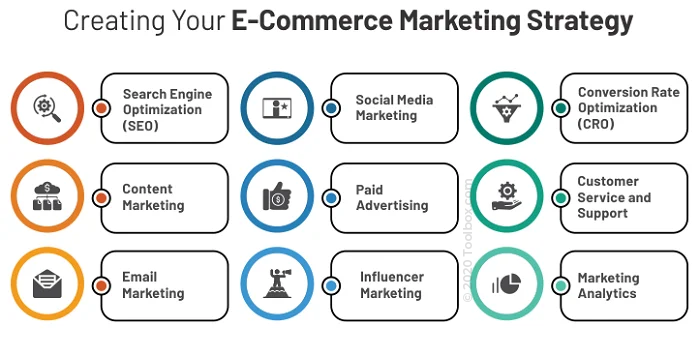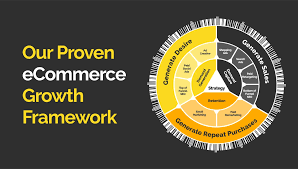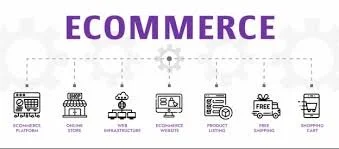How to Establish a Growth Marketing Strategy for Your E-Commerce Business
Establishing a growth marketing strategy for ecommerce stores can involves numerous tactics working both simultaneously and at different times.
The e-commerce industry has grown exponentially, with total e-commerce sales for Q3 alone reaching $284 billion, with sales surpassing $1 trillion in total for 2023.
By 2040, it is estimated that 95% of purchases will be made online. With consumers increasingly relying on online shopping, e-commerce is opening doors of opportunity to many entrepreneurs.
Furthermore, those e-commerce sale opportunities are growing at a rapid rate. However, as more e-commerce businesses start to emerge, standing out becomes more challenging.
In this article, we will examine how to go about creating a growth marketing strategy for your e-commerce business. We will also look at the key characteristics of creating a growth marketing strategy, the benefits of creating a growth marketing foundation for e-commerce stores, and how the growth marketing framework can be applied specifically for e-commerce businesses. Finally, we will go about outlining the steps needed to create a growth marketing strategy for your e-commerce store, as well as highlight 10 specific tactics that can (and generally speaking, ought to) be part of a series of growth marketing tactics for your e-commerce shop.
What Exactly is E-Commerce?
E-commerce is a business model in which business transactions are done over the World Wide Web.
E-commerce is not to be confused with e-business, as e-business involves businesses conducting their activities online while e-commerce involves business transactions between buyers and sellers over electronic media.
E-commerce can involve a wide range of options including online shopping, drop shipping, crowdfunding, electronic payment, online subscriptions, and digital transactions.
What are the Different Types of E-commerce Businesses?
There are four main types of e-commerce which we will go over below.
Business-to-consumer involves the direct business transaction between businesses and their consumers online. Out of all the 4 models, it is the one which aligns most similarly with retail. Examples of companies that practice the B2C e-commerce model include Amazon and Well.ca.
B2B is an e-commerce model where businesses carry out business transactions with other businesses over an electronic medium. What is involved is that products or services are usually exchanged with other businesses which might then sell directly to consumers or use them to benefit various aspects of their operations (ex; manufacturing, safety, etc.). The B2B e-commerce model examples can be seen in small businesses buying goods from Alibaba to resell to consumers.
Consumer-to-Business (C2B)
This is the least common of the 4 e-commerce models. This business model involves consumer products and/or services directly with a business over an electronic means. The consumer-to-business e-commerce model is a direct sales business model, and it generally not involve a middleman or a wholesaler. Examples of the C2B model can be seen in an artist licensing his artwork to a business or freelance social media influencers offering marketing services to businesses on Fiverr.
Consumer-to-Consumer (C2C):
The consumer-to-consumer e-commerce model is also referred to as the peer-to-peer (P2P) e-commerce business model. This e-commerce model involves the electronic exchange of goods, services, or information between consumers through a third-party platform such as Kijiji or Facebook Marketplace. These third-party platforms are usually referred to as peer-to-peer selling platforms. C2C is a direct opposite of the consumer-to-business e-commerce model where consumers exchange their products and/or services with a business.
What are the main benefits that running an e-commerce business provides?
The impact of e-commerce reverberates around the world, both for businesses and consumers. These benefits include:
The sheer variety and volume of different products and services that one can make available to the market.
The ability for businesses to reach a variety of potential consumers from different countries around the world.
Related to the previous point, the simplicity of offering products and services online and the ease of access it provides for consumers.
The fact that there are number of ways of purchasing goods and services online (ex; bank transfer, PayPal, credit and debit cards, cryptocurrency etc.)
What are the main challenges inherent with e-commerce businesses?
Unlike purchasing in-store, ordering products requires that you wait a certain amount of time to receive them (delivery)
Security can be an issue, both in the sense that online retailers can potentially sell fake or spam products, and that websites acquire sensitive personal information about their customers
You cannot feel, sense, try, and analyze products before you buy them online
As much as e-commerce stores can do their best to answer questions that customers may have about their products, the ability to explain or demonstrate product capabilities and differences is severely limited
What are The Benefits of Creating a Growth Marketing Plan For Your E-Commerce Store?
We have so far established some background information about e-commerce businesses as well as what it entails, the various types of e-commerce, as well as some inherent advantages and disadvantages that e-commerce businesses and e-commerce as a whole provides for consumers. Now that we have done that, we need to examine how to go about helping your e-commerce business become more than just another online store that exists. You need for it to stand out and set apart from other stores that are like it. That is where creating a growth marketing strategy comes into play.
Rather than fixating on one stage of your funnel, growth marketing focuses on the customer journey as a whole. It is a strategy that is oriented with the long game in mind, one that is as focused on building customer relationships and fostering loyalty as it is on awareness and acquisition.
At every stage of the customer journey, a growth marketing plan will analyze data to generate insights that inform strategic initiatives. To quickly learn from and iterate on these initiatives, business owners and leaders need to establish a culture that celebrates creative problem-solving, experimentation, and agility.
This is by and large the greatest benefit of establishing what exactly the growth marketing framework entails for e-commerce stores . Growth happens at every stage of the funnel. Rather than acquiring a large volume of new customers or leads who eventually churn, you are focused on acquiring and retaining customers who go on to become advocates for your brand.
The entire funnel is considered and marketing is incentivized to pursue campaigns and tactics that generate leads that fit the various stages of the customer journey. Those leads gained today will be retained and primed to expand in the future, contributing to greater business growth overall in the long term. Once marketing activities start bringing higher-quality customers into the funnel, your ROI will start to soar and more budget will be unlocked to continue expanding on or experimenting with growth strategies.
Furthermore, since a growth marketing plan focuses on all parts of the funnel, your attribution model and return on investment (ROI) calculations need to consider the long-term customer value. Every major KPI including customer lifetime value (CLV), monthly recurring revenue (MRR), churn rate, and activation rate needs to be attributed to understanding how and to what degree at every step along the way, your business is benefiting from strategic, messaging and operational adjustments stemming from tactics performed at every point along the e-commerce purchasing funnel.
What Are the Key Characteristics of a Growth Marketing Strategy
To put it in simple terms, a growth marketing framework is a way of examining the customer purchasing process. The idea here in analyzing the whole experience is to help a business grow as quickly as possible and most strategically. It is not just another generic marketing tactic, but rather a precise, targeted, ongoing approach required to stimulate growth, involving critical steps that take the position of the business and where it needs to get to into account.
Growth marketing considers the entire business cycle as a potential lever for growth. Now depending on the nature of the business itself, the specific framework can differ. Just as a reminder, the growth marketing framework consists of :
A: Acquisition
A: Activation
R. Retention
R. Revenue
R. Referral
This framework was created as a way of giving small companies a method by which to focus on the right metrics, and more importantly, the events/occurrences that truly impact their business’s success. By shifting a business’s focus to the channels and tactics that move the needle most at every stage, smaller companies can find a way to thrive and, in many cases, even outperform bigger competitors. They evaluate the best channels to focus on by looking at metrics such as the number of interested visitors, conversion rates, ROI, CPA, etc. This framework has allowed many businesses to maximize growth on a comparably razor-thin budget.
How Does One Apply the Growth Marketing Framework to E-Commerce Stores?
Applying a growth marketing framework to ecommerce stores has numerous complexities.
Now let’s look at how the growth marketing framework applies to e-commerce businesses at every stage of the funnel. Of course, AARRR metrics are traditionally applicable to SaaS (software as a service) companies, but we believe that it’s a concept that can easily be adopted by e-commerce businesses (and other businesses) to drive consistent and repeatable growth to your online store.
However, if we are concerned about the precise order of the framework as it pertains to the e-commerce framework, we just need to make a few changes to the order of the metrics. It is worth noting that for SaaS businesses revenue comes after retention (during the free trial or the product demonstration). For e-commerce stores, the revenue part (placing an order) usually happens before retention (repeat purchases).
A: Acquisition:
Acquisition is basically how you “acquire” visitors. For e-commerce stores, the bulk of the traffic these days comes from search engines (Google, Bing), social networks (Facebook, Twitter (X), Pinterest as well as via influencer campaigns), and pay-per-click ads through advertising giants like Google AdWords and Facebook Ads.
A: Activation:
Activation in ecommerce means either signing up for the product or subscribing to a newsletter. For the purpose of KPI metrics, activation can be “measured” through a few key visitor activities.
Signing up – some online stores still require and encourage creating accounts with them.
Subscribing for a newsletter
Starting the checkout process
Adding a product to their shopping cart
Browsing at least a few products or product categories
Actually making a purchase


